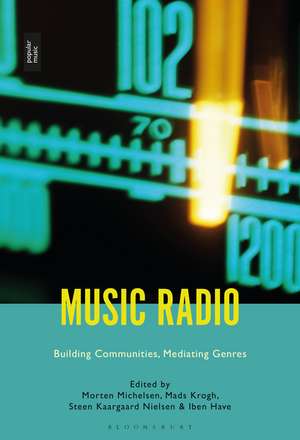Music Radio: Building Communities, Mediating Genres
Editat de Prof Morten Michelsen, Mads Krogh, Steen Kaargaard Nielsen, Iben Haveen Limba Engleză Paperback – 24 iun 2020
| Toate formatele și edițiile | Preț | Express |
|---|---|---|
| Paperback (1) | 226.42 lei 6-8 săpt. | |
| Bloomsbury Publishing – 24 iun 2020 | 226.42 lei 6-8 săpt. | |
| Hardback (1) | 777.06 lei 6-8 săpt. | |
| Bloomsbury Publishing – 26 dec 2018 | 777.06 lei 6-8 săpt. |
Preț: 226.42 lei
Preț vechi: 289.75 lei
-22% Nou
Puncte Express: 340
Preț estimativ în valută:
43.32€ • 45.36$ • 35.85£
43.32€ • 45.36$ • 35.85£
Carte tipărită la comandă
Livrare economică 07-21 aprilie
Preluare comenzi: 021 569.72.76
Specificații
ISBN-13: 9781501365454
ISBN-10: 1501365452
Pagini: 344
Ilustrații: 17 bw illus
Dimensiuni: 152 x 229 x 24 mm
Greutate: 0.45 kg
Editura: Bloomsbury Publishing
Colecția Bloomsbury Academic
Locul publicării:New York, United States
ISBN-10: 1501365452
Pagini: 344
Ilustrații: 17 bw illus
Dimensiuni: 152 x 229 x 24 mm
Greutate: 0.45 kg
Editura: Bloomsbury Publishing
Colecția Bloomsbury Academic
Locul publicării:New York, United States
Caracteristici
Discusses how music radio contributes to the formation and regulation of communities
Notă biografică
Mads Krogh is Associate Professor at the School of Communication and Culture, section for Musicology, Aarhus University, Denmark. Morten Michelsen is Associate Professor in the Section for Musicology, University of Copenhagen, Denmark. Steen Kaargaard Nielsen is Associate Professor at the School of Communication and Culture, section for Musicology, Aarhus University, Denmark. Iben Have is Associate Professor at Aarhus University, Denmark, in the Section for Media and Journalism Studies.
Cuprins
IntroductionComplexities of Genre, of Mediation and of CommunityMads Krogh and Morten MichelsenSection I: Music Radio Ethnographies 1. Migrant Radio, Community and (New) Fado: The Case of Radio ALFA Pedro Moreira, Universidade Nova, Portugal 2. On Sonic Assemblage: Indigenous Radio and the Management of HeteroglossiaDaniel Fisher, University of California, Berkeley, USA3. Voicing Otherness on Air: Theorizing Radio Through the Figure of VoiceKristine Ringsager, Aalborg University, Denmark, and Sandra Lori Pedersen, University of Copenhagen, DenmarkSection II: Music Radio and Nation Building4. Broadcasting the New Nation: Radio and the Intentions Behind National Genres in Latin America Marcio Pinho and Julio Mendivil, Goethe-Universität, Frankfurt5. The Edufication and Musicalization of Radio: CKUA, "Good Music," and "Uplifting Taste"Brian Fauteux, University of Alberta, Canada6. Mediated Soundscapes: Representations of the National in the Soundscape Call-in Programme Äänien iltaMeri Kytö, University of Tampere, Finland7. Dispositives of Sound: Folk Music Collections, Radio and the National Imagination, 1890s-1960sJohannes Müske, University of Zürich, Switzerland Section III: Music Radio: Genre and Mediation8. Mediatization - Radiofication - MusicalizationAlf Björnberg, University of Gothenburg, Sweden9. Formats, Genres and Abstraction: On Musico-Generic Assemblages in the Context of Format Radio ProductionMads Krogh, Aarhus University, Denmark10. Music Radio's Mediations of the Music-Cultural High/Low Divide Before the 1980sMorten Michelsen, University of Copenhagen, DenmarkSection IV: Music Radio Convergences11. Format, the Literature of American Popular Music and Mr CrumpEric Weisbard, University of Alabama, USA12. MTV and the Remediation of FM radioAriane Holzbach, Federal Fluminense University, Brazil13. Music Radio as a Format Remediated for the Stream-Based Music UseAndreas Ægidius, University of Southern Denmark
Recenzii
Music Radio offers valuable theoretical insight and workable analytical approaches to a highly under-researched field - considering the enormous impact of music radio in history right until today. Reflecting the diversity of radio cultures' dependency on infrastructures, media regulation, music markets and audience indentities, the book qualifies for teaching and scholarly purposes alike.
This volume is a welcome contribution to the growing literature on music and radio. Most exciting is the global reach of the case studies - eclectic programming on indigenous radio in Australia and community radio in Canada, a Finnish soundscape call-in show, popular music on radio in mid-twentieth-century Brazil and Peru, and diasporic DJs in Denmark, to name a few examples. Readers will appreciate the thoughtful reflections on genre and community by the editors and their contributors.
Rich in empirical case studies and theoretical reflection, this inspiring collection on music radio amply demonstrates how interdisciplinary dialogue can afford new insights into the complexity and significance of one of the most ubiquitous and deceptively familiar media forms.
This unique volume presents an international and multi-disciplinary examination of music radio and its diversity of styles, audiences, communicative and institutional forms, markets, and national settings. The international scholars, their dialog across the chapters, and their diverse case studies further our understanding of music radio and test our concepts of genre, mediatization, and community.
This volume is a welcome contribution to the growing literature on music and radio. Most exciting is the global reach of the case studies - eclectic programming on indigenous radio in Australia and community radio in Canada, a Finnish soundscape call-in show, popular music on radio in mid-twentieth-century Brazil and Peru, and diasporic DJs in Denmark, to name a few examples. Readers will appreciate the thoughtful reflections on genre and community by the editors and their contributors.
Rich in empirical case studies and theoretical reflection, this inspiring collection on music radio amply demonstrates how interdisciplinary dialogue can afford new insights into the complexity and significance of one of the most ubiquitous and deceptively familiar media forms.
This unique volume presents an international and multi-disciplinary examination of music radio and its diversity of styles, audiences, communicative and institutional forms, markets, and national settings. The international scholars, their dialog across the chapters, and their diverse case studies further our understanding of music radio and test our concepts of genre, mediatization, and community.
